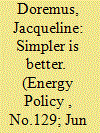| Srl | Item |
| 1 |
ID:
094249


|
|
|
|
|
| Publication |
2010.
|
| Summary/Abstract |
Climate change has come to the forefront of Australian politics and there is now an active on-going policy debate about how to best reach a commonly agreed long term goal. This paper looks at five major dimensions of this debate and constructs policy options based on them. A discrete choice experiment approach was used with a representative sample from a major internet panel provider. Survey respondents made choices between pairs of policy options with different characteristics. They favored policies starting in 2010 rather than 2012, and spending 20% of revenue raised on energy-related R&D. They were almost evenly split on whether the plan should initially exempt the transport sector and two competing approaches that redistribute revenue from the plan, and, they opposed plans giving special treatment to energy-intensive sectors of the economy. A number of other policy relevant questions related to understanding Australian views and knowledge related to climate change also were asked.
|
|
|
|
|
|
|
|
|
|
|
|
|
|
|
|
| 2 |
ID:
166550


|
|
|
|
|
| Summary/Abstract |
When agencies such as the US Environmental Protection Agency (EPA) establish future greenhouse gas emissions standards for new vehicles, forecasting future vehicle purchases due to changes in fuel economy and prices provides insight into regulatory impacts. We compare predictions from a nested logit model independently developed for US EPA to a simple model where past market share predicts future market share using data from model years 2008, 2010, and 2016. The simple model outperforms the nested logit model for all goodness-of-prediction measures for both prediction years. Including changes in vehicle price and fuel economy increases bias in forecasted market shares. This bias suggests price increases are correlated with unobserved increases in vehicle quality, changes in preferences, or brand-specific changes in market size but not cost pass-through. For 2010, past shares predict better than a nested logit model despite a major shock, the economic disruption caused by the Great Recession. Observed share changes during this turbulent period may offer upper bounds for policy changes in other contexts: the largest observed change in market share across the two horizons is 6.6% for manufacturers in 2016 and 3.4% for an individual vehicle in 2010.
|
|
|
|
|
|
|
|
|
|
|
|
|
|
|
|
| 3 |
ID:
176724


|
|
|
|
|
| Summary/Abstract |
This article explores technology ownership patterns to reveal adoption trends for energy efficiency measures (EEMs) in the Greek residential sector. To do so, we couple observational survey data with discrete choice modeling. Household preferences are revealed through EEMs owned by Greek householders, after having been questioned for a variety of end-use measures and details about their specification. Our results confirm prior evidence on traditional determinants οf technology adoption and extend those by validating that households familiar with information and communication technologies (ICTs) are more likely to own EEMs with smart features. We were also able to highlight the positive influence of participation in subsidy, as well as other support programmes for vulnerable consumers in households’ ownership of EEMs. Our results are then used to simulate the change in technology ownership rates, under no and full participation in a subsidy programme, for three income levels. Simulation outcomes suggest that, for almost all EEMs, the probability for technology ownership is greater for higher-income households benefitting from a subsidy. Nevertheless, the change in the probability of technology ownership due to the subsidy is larger for low- and medium-income households participating in the programme, further encouraging, thus, support for financial policies targeting lower-income households.
|
|
|
|
|
|
|
|
|
|
|
|
|
|
|
|